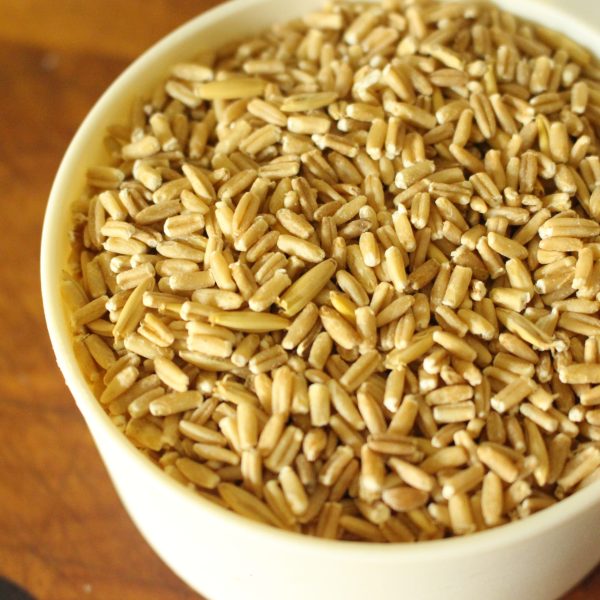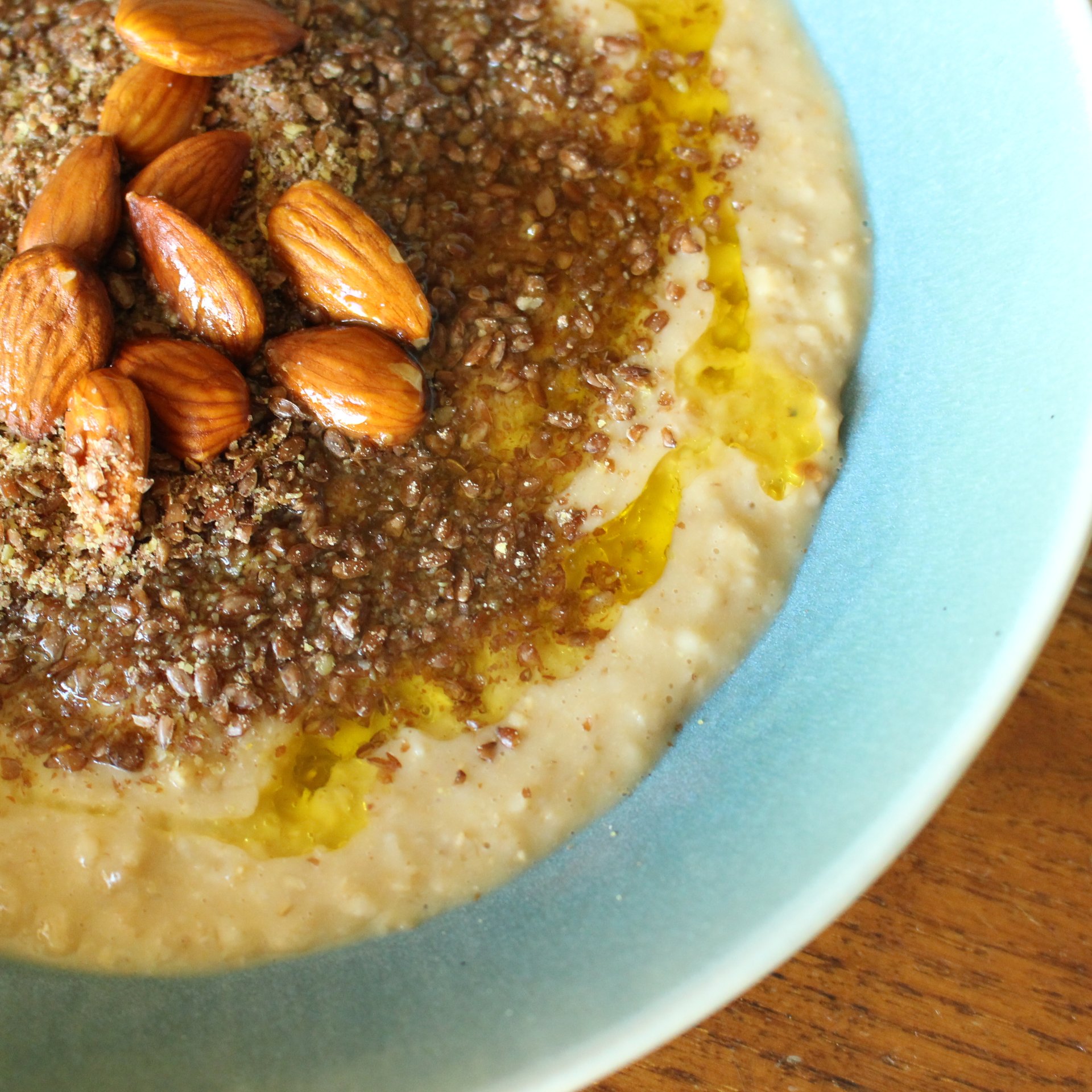This post contains affiliate links, which means that if you click on one of the links and make a purchase, I may receive a small commission. This commission comes at no additional cost to you and helps me to continue putting ancestral food information out into the world.
In this post I will share how to roll your own oats at home, but first let’s talk about why you’d want to do it!
As conscious eaters, we often think about how the meat on our plate was raised or what condition the chickens who laid our breakfast eggs were kept in. But how often do we stop and consider what happened to the grains that accompany our meals before they got to our kitchens?
Most of the grains that we consume have had quite a journey before they’ve got to us. Following the story of oats gives us a good example.

How oats are processed in factories
Even if we buy oats whole, by that I mean as the oat grain (often called a groat), these grains, after harvest, will have been processed with heat and steam in a factory.
This processing stops the oats going rancid. The hulls of standard oats (as opposed to naked oats) are particularly difficult to remove and the oat grain often gets damaged during that removal. This damage exposes the fats in the grain to the air, which quickly results in rancidity.

But if you buy your oats pre-rolled, the processing hasn’t stopped there.
In order to roll an oat grain (a process that was invented by industrialists in the 1800s), even more machines are needed. This is because oats, when put through industrial rollers, will break up, creating a lot of dust. In order to avoid this, grains destined to be rolled oats are reprocessed in steam temperatures that go above 100C (212F). This gelatinises some of their starch meaning that the oats roll with less waste.
Thanks to the work of campaigners, most of us are aware that industrial food processing decreases the nutritional value of our food. This is true of oats.
Their first pass – to stop them from going rancid – does result in some nutrient loss. Manufacturers work hard to balance protecting the oat grains from rancidity and preserving their vitamins, minerals and enzymes but still, it happens. Yet frankly, I’ll take that; because without it those oats wouldn’t make it to my kitchen in a healthy state, let alone my table.
The second pass that oats go through – to make them into rolled oats – results in even more nutrient loss. This subsequent round of heat and steam is not necessary. We can roll our own oats at home, from the oat grain, and capture those nutrients for us and our family.
3 Good Reason to Roll Your Own Oats
As you can see reason number one to roll your own oats is to get more nutrients:
1 – Higher nutrient content
If you roll your oats at home just before you cook with them, your resulting dish will be much higher in nutrients. For example, lab tests have shown that:
- Vitamin B3 content is 71% higher in home-rolled oats compared to shop-bought rolled oats.
- Vitamin B6 content is 900% higher in home-rolled oats compared to shop-bought rolled oats.
- The enzyme lipase has eight times as much activity in home-rolled oats compared to shop bought oats.

2 – Much More Flavour
If you roll your oats at home, they’ll be tastier – so much tastier than industrially rolled oats. They are fresher and more nutrient dense, so no wonder they taste better! I find them to be sweeter, more toasty and generally more satisfying.
3 – Economy
If you roll your oats home, they can be cheaper. When purchasing whole grains, you can buy and store large quantities (in a way the that you wouldn’t want to with pre-rolled, processed oats). This enables you to utilise substantial bulk discounts to save money.
How to Roll Oats At Home:
In order to roll your own oats freshly at home you will need:
- Whole oat grains (often called groats): These can be purchased in small amounts from your local health food store or in large quantities from a mill or bulk food supplier.
- A grain flaker: There are more of these on the market than most people realise! Here’s a few that I, or people I know, have experience with:
Mockmill Flake Lovers

The Mockmill Flake Lover is a tabletop electric flaker. You feed the oat grains in the top and rolled oats come out the bottom (at a speed of 100g per minute – which is less than two minutes for two bowls of oatmeal).
The pros of this flaker are that it’s counter-top, relatively quick and requires no manual input from you other than feeding the oats into the hopper (which holds 200g of oat groats at anyone time).
To buy the Mockmill Flake Lovers in the US click here.
To buy the Mockmill Flake Lovers in the UK click here.
If you use one of the above links, you’ll be supporting my work. Thank you!
Mockmill Flaker Attachment for the KitchenAid
This was designed for the KitchenAid but can also be used on other food processors. You attach it to the processor and it can mill one cup of oat flakes a minute which will give you three to four servings of oatmeal. (The hopper at the top holds three and half cups of oat groats.)
To buy the Mockmill Flaker Attachment for the KitchenAid in the US click here.
To buy the Mockmill Flaker Attachment for the KitchenAid in the UK click here.
If you use one of the above links, you’ll be supporting my work (without paying any extra). Thank you!
Marcato Marga
The Marcato Marga is handcranked roller mill. I’ve had one for over five years and it’s made many, many batches of home rolled oats.

The upsides of it compared to the Mockmill Flake Lover is that it’s quiet, doesn’t require electricity and has rollers that you can adjust manually to alter the thickness of the flake. This adjustment facility means the mill is great for preparing the oats necessary for making the Scottish oat ferment, Sowans.
The downsides of it compared to the Mockmill Flake Lover are that it needs manual processing – requiring 20 to 25 minutes of hands-on time to produce a kilogram (two pounds) of oat flakes; and, unless you purchase the attachable motor, all of that time the mill is powered by your arm!
There are other flakers is available. Komo, Mockmill’s competitor produce roller mills and Eschenfelder also make a range of flakers.
Rolling at home is not just about oats!
Whichever one you choose, remember that it’s not just oats that you can flake! Wheat, rye, barley, einkorn, emmer and spelt can all be flaked too. Choosing one of these machines not only means getting more nutrition from your morning oats but also gives you endless creative opportunities!

Graph and Mockmill photos courtesy of Mockmill. Other photos from my kitchen!

Bring ancient grain baking into your kitchen!
Download my free 30-page guide with five healthy and tasty 100% ancient grains recipes.


Very valuable information. I do wish you had listed their price at the time this post was made.
I and a friend are both very interested in ancient grains.
I just signed up for your email and am looking forward to receiving them.
Hi Gayle,
Thank you for your thoughts. Listing the pricing is complicated as I have readers in the US/UK/Europe/Australia and beyond and the prices/exchange rates change. I’m glad you found me – my podcast has quite a few episodes/resources on ancient grains which might be helpful 🙂
Hi there
I loved your post.
What is your opinion on the anti nutrients in oats and the need to soak them overnight?
Thanks a lot for all your information
Anna
Hi Anna, I have many posts on this, a You Tube video and a podcast episode. Maybe start with the You Tube video? It’s here: https://youtu.be/8hX42xbojbM. You can then find links to the articles on my home page and the podcast episode (called ‘Fermenting Oats’) at ancestralkitchenpodcast.com. I hope this helps.